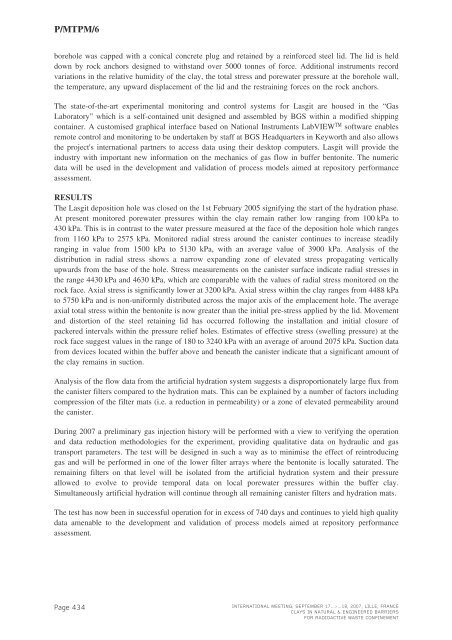Mass Transfer & Porous Media (MTPM) - Andra
Mass Transfer & Porous Media (MTPM) - Andra
Mass Transfer & Porous Media (MTPM) - Andra
Create successful ePaper yourself
Turn your PDF publications into a flip-book with our unique Google optimized e-Paper software.
P/<strong>MTPM</strong>/6borehole was capped with a conical concrete plug and retained by a reinforced steel lid. The lid is helddown by rock anchors designed to withstand over 5000 tonnes of force. Additional instruments recordvariations in the relative humidity of the clay, the total stress and porewater pressure at the borehole wall,the temperature, any upward displacement of the lid and the restraining forces on the rock anchors.The state-of-the-art experimental monitoring and control systems for Lasgit are housed in the “GasLaboratory” which is a self-contained unit designed and assembled by BGS within a modified shippingcontainer. A customised graphical interface based on National Instruments LabVIEW TM software enablesremote control and monitoring to be undertaken by staff at BGS Headquarters in Keyworth and also allowsthe project's international partners to access data using their desktop computers. Lasgit will provide theindustry with important new information on the mechanics of gas flow in buffer bentonite. The numericdata will be used in the development and validation of process models aimed at repository performanceassessment.RESULTSThe Lasgit deposition hole was closed on the 1st February 2005 signifying the start of the hydration phase.At present monitored porewater pressures within the clay remain rather low ranging from 100 kPa to430 kPa. This is in contrast to the water pressure measured at the face of the deposition hole which rangesfrom 1160 kPa to 2575 kPa. Monitored radial stress around the canister continues to increase steadilyranging in value from 1500 kPa to 5130 kPa, with an average value of 3900 kPa. Analysis of thedistribution in radial stress shows a narrow expanding zone of elevated stress propagating verticallyupwards from the base of the hole. Stress measurements on the canister surface indicate radial stresses inthe range 4430 kPa and 4630 kPa, which are comparable with the values of radial stress monitored on therock face. Axial stress is significantly lower at 3200 kPa. Axial stress within the clay ranges from 4488 kPato 5750 kPa and is non-uniformly distributed across the major axis of the emplacement hole. The averageaxial total stress within the bentonite is now greater than the initial pre-stress applied by the lid. Movementand distortion of the steel retaining lid has occurred following the installation and initial closure ofpackered intervals within the pressure relief holes. Estimates of effective stress (swelling pressure) at therock face suggest values in the range of 180 to 3240 kPa with an average of around 2075 kPa. Suction datafrom devices located within the buffer above and beneath the canister indicate that a significant amount ofthe clay remains in suction.Analysis of the flow data from the artificial hydration system suggests a disproportionately large flux fromthe canister filters compared to the hydration mats. This can be explained by a number of factors includingcompression of the filter mats (i.e. a reduction in permeability) or a zone of elevated permeability aroundthe canister.During 2007 a preliminary gas injection history will be performed with a view to verifying the operationand data reduction methodologies for the experiment, providing qualitative data on hydraulic and gastransport parameters. The test will be designed in such a way as to minimise the effect of reintroducinggas and will be performed in one of the lower filter arrays where the bentonite is locally saturated. Theremaining filters on that level will be isolated from the artificial hydration system and their pressureallowed to evolve to provide temporal data on local porewater pressures within the buffer clay.Simultaneously artificial hydration will continue through all remaining canister filters and hydration mats.The test has now been in successful operation for in excess of 740 days and continues to yield high qualitydata amenable to the development and validation of process models aimed at repository performanceassessment.Page 434INTERNATIONAL MEETING, SEPTEMBER 17...>...18, 2007, LILLE, FRANCECLAYS IN NATURAL & ENGINEERED BARRIERSFOR RADIOACTIVE WASTE CONFINEMENT
















